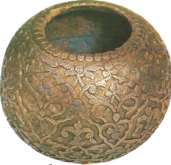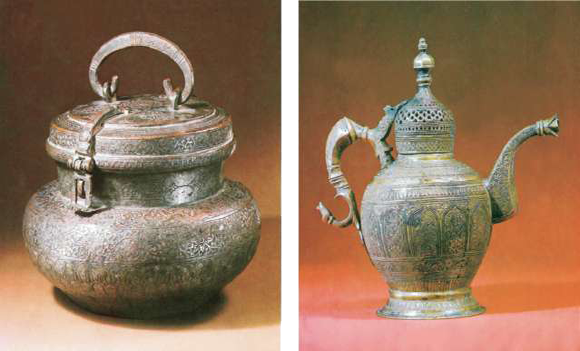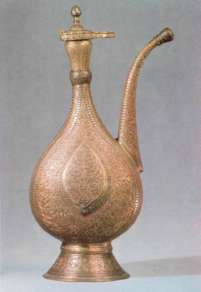 The art of relief processing the art of metal products – торевтика – ancient origin only in artistic ceramics. In the most ancient period was dominated by articles made of bronze. Later the local торевты created their works from gold, silver, copper and other metals, creating masterpieces of art. Торевтика the antiquity and the early middle ages is mainly represented by the products of silver with gold, and, starting XI. the main products of craftsmen- toreutics become a product of copper and its alloys. Of particular rise in the development of toreutics Uzbekistan is typical for позднеан- тичного and early medieval periods (III – VII centuries). During this time art products made of precious metals – gold and silver, intended for the the rulers, the nobility and wealthy layers the company, acquire a secular subjects scenes of celebrations and throne восседа- Igor Abdullayev Openwork metal music (Chasing and the history of its development in Uzbekistan) the hunting feats, martial arts, and religious-mythological scenes. They include images of mythological and epic heroes, different deities, images of fantastic creatures and real birds, animals. In the IX – X of centuries in connection with Islamization in areas of Central Asia appears style, synthesizing the tradition of IP-кусства different peoples, included in the composition of the the Caliphate, the new ideological-tion of the basis. Urban growth and expansion of the environment consumption of metal products various-purpose stimulated the development of mass craft production, raw material needs which precious metals satisfy could not, have contributed to the prosperity of the crafts, mass distribution of the cheaper – copper products and copper alloys (bronze, tin, lead, silver, in many cases заменявших objects of gold and silver. In the middle of XI century in the application art of Central Asia is changing art the style of decoration products, predominance of national ornamental- decorative beginning.
The art of relief processing the art of metal products – торевтика – ancient origin only in artistic ceramics. In the most ancient period was dominated by articles made of bronze. Later the local торевты created their works from gold, silver, copper and other metals, creating masterpieces of art. Торевтика the antiquity and the early middle ages is mainly represented by the products of silver with gold, and, starting XI. the main products of craftsmen- toreutics become a product of copper and its alloys. Of particular rise in the development of toreutics Uzbekistan is typical for позднеан- тичного and early medieval periods (III – VII centuries). During this time art products made of precious metals – gold and silver, intended for the the rulers, the nobility and wealthy layers the company, acquire a secular subjects scenes of celebrations and throne восседа- Igor Abdullayev Openwork metal music (Chasing and the history of its development in Uzbekistan) the hunting feats, martial arts, and religious-mythological scenes. They include images of mythological and epic heroes, different deities, images of fantastic creatures and real birds, animals. In the IX – X of centuries in connection with Islamization in areas of Central Asia appears style, synthesizing the tradition of IP-кусства different peoples, included in the composition of the the Caliphate, the new ideological-tion of the basis. Urban growth and expansion of the environment consumption of metal products various-purpose stimulated the development of mass craft production, raw material needs which precious metals satisfy could not, have contributed to the prosperity of the crafts, mass distribution of the cheaper – copper products and copper alloys (bronze, tin, lead, silver, in many cases заменявших objects of gold and silver. In the middle of XI century in the application art of Central Asia is changing art the style of decoration products, predominance of national ornamental- decorative beginning.  The most common reception of application of ornament becomes engraving, the most reflecting the basic principles of decorative-flatness, “ковро- ance of the” pattern. All rarely used relief stamping. New – elegant and easy forms of objects. In торевтике IX – XII centuries widespread got эпиграфический ornament, not familiar раннесредневеко- renowned art. Inscriptions script “strict” and “blooming” – “kufi” and “Naskh” consisted of trivial welfare- the desires of the type “fame, success, health, happiness, well-being”, etc., the nameless the owner of the vessel or of the Cup. As in enameled ceramics that time, inscription gradually стилизуются, become a illegible and turn in a kind of written ornament. The desire of craftsmen-chasers to sophistication of the ornamental pattern and elegance of forms of vessels increases in XIII-XV centuries. Frequently used inlay patterns of silver and gold threads. Preserved славившееся in the the time of the Central Asian arms: decorated with rich chasing the pattern and overhead patterns of precious metals and bright gems shields, helmets, swords, daggers, fighting puffins, wide belt. In the XVIII – XX centuries, the city of Khiva, Bukhara, Kokand, Samarkand, Karshi, Shakhrisabz, Tashkent become the main centers of production of embossed products. Stamping of thin – manual work, performed quite simple tool пелад – калямом, of which diverse. Калямы used in depending on the nature of ornament and techniques of pattern. In addition, the the set of tools had a hammer and items for surface grinding product after minting (Rand and мискал – type of files). For the application of shape drawing on the surface of the product chasers sometimes used a pair of compasses. But experienced engravers, knowing hundreds of patterns, do not resort to a pre – application of shapes and cause it immediately with a chisel. Usually the embosser sitting on the the floor in front of a low wooden table, on which is placed a pillow of the thick layer of special var Kandal – it the elastic and plastic surface is very easy to work (it reflects and softens the blows of the hammer on каляму). Kandal – wort juice plants growing on the territory of India and Iran. Cold var master attaches it to the the top surface of the table. Holding cutter fingers of his left hand, chaser right hand abruptly, but gently hits hammer on the upper end of the inclined put the cutter. During the stamping hollow high vessels of the inside of them is filled with sand or rags which is stamped by. After the coining of a pattern, master cleans up its contours, trims and align the edge, seeking grace lines, and then starts processing the background patterns. The last operation is polishing the surface of the product, a pattern which is applied irrigation and chasing the way. Irrigation – the withdrawal of pattern with the help of a metal or bronze deck, on which drumming hammer overlaid copper or lead record. Appears the pattern on the record, which was assigned on the product. The second – hammered way, had two kinds: of beaten work and painted – auxiliary. In the background use auxiliary methods finishing. The General evolution of style Central Asian coinage was accompanied by at the same time and the formation of its local schools, fully formed in the In XIX century. В1967, in Khiva school was opened artistic production. Khorezm school of minting especially stable in the preservation of forms and ornamentation. Khorezmian jugs for water all species is similar in form and decoration on a similar vessels of other regions, where they are called differently.
The most common reception of application of ornament becomes engraving, the most reflecting the basic principles of decorative-flatness, “ковро- ance of the” pattern. All rarely used relief stamping. New – elegant and easy forms of objects. In торевтике IX – XII centuries widespread got эпиграфический ornament, not familiar раннесредневеко- renowned art. Inscriptions script “strict” and “blooming” – “kufi” and “Naskh” consisted of trivial welfare- the desires of the type “fame, success, health, happiness, well-being”, etc., the nameless the owner of the vessel or of the Cup. As in enameled ceramics that time, inscription gradually стилизуются, become a illegible and turn in a kind of written ornament. The desire of craftsmen-chasers to sophistication of the ornamental pattern and elegance of forms of vessels increases in XIII-XV centuries. Frequently used inlay patterns of silver and gold threads. Preserved славившееся in the the time of the Central Asian arms: decorated with rich chasing the pattern and overhead patterns of precious metals and bright gems shields, helmets, swords, daggers, fighting puffins, wide belt. In the XVIII – XX centuries, the city of Khiva, Bukhara, Kokand, Samarkand, Karshi, Shakhrisabz, Tashkent become the main centers of production of embossed products. Stamping of thin – manual work, performed quite simple tool пелад – калямом, of which diverse. Калямы used in depending on the nature of ornament and techniques of pattern. In addition, the the set of tools had a hammer and items for surface grinding product after minting (Rand and мискал – type of files). For the application of shape drawing on the surface of the product chasers sometimes used a pair of compasses. But experienced engravers, knowing hundreds of patterns, do not resort to a pre – application of shapes and cause it immediately with a chisel. Usually the embosser sitting on the the floor in front of a low wooden table, on which is placed a pillow of the thick layer of special var Kandal – it the elastic and plastic surface is very easy to work (it reflects and softens the blows of the hammer on каляму). Kandal – wort juice plants growing on the territory of India and Iran. Cold var master attaches it to the the top surface of the table. Holding cutter fingers of his left hand, chaser right hand abruptly, but gently hits hammer on the upper end of the inclined put the cutter. During the stamping hollow high vessels of the inside of them is filled with sand or rags which is stamped by. After the coining of a pattern, master cleans up its contours, trims and align the edge, seeking grace lines, and then starts processing the background patterns. The last operation is polishing the surface of the product, a pattern which is applied irrigation and chasing the way. Irrigation – the withdrawal of pattern with the help of a metal or bronze deck, on which drumming hammer overlaid copper or lead record. Appears the pattern on the record, which was assigned on the product. The second – hammered way, had two kinds: of beaten work and painted – auxiliary. In the background use auxiliary methods finishing. The General evolution of style Central Asian coinage was accompanied by at the same time and the formation of its local schools, fully formed in the In XIX century. В1967, in Khiva school was opened artistic production. Khorezm school of minting especially stable in the preservation of forms and ornamentation. Khorezmian jugs for water all species is similar in form and decoration on a similar vessels of other regions, where they are called differently. In Khiva “fat” jugs for water called “тунча”. Some of them had cover and the handles of pots. Local originality in embossed copper products was and then, except that the jars were used and copper buckets “кашкул”. Unique, for example, the basin for washing, called in Khorezm “селобча”, and not “дастшуй”, as in other areas of Uzbekistan. They have higher tank, some even have a stand (CAPI). Nowhere in Uzbekistan, except Khorezm, not produce vessels for water – original “Kumgang”. In other regions of the they are called “oftoba”. Kumgan differs from oftoba that has pens. It is more flat in the form, has long and narrow neck. The peculiarity of the Khiva technology – smooth background, without finishing. Products masters of Khiva school strict and rich. Color of the background they don’t do, moderately using only black and red lucky, and the background is decorated strokes – parallel lines and much less often – the punch. Widely used хорезмскими chasers medallions – “турунж” (from alabe, “lemon”) and grid complex configurations. In the ornament of Khiva chasers dominated by elements of vegetable nature, among which the popular “aylanma islimi” – in the form of curls escape, tightly twisted in a spiral and the 5-6 spade flowers, depicted in the face and in profile. From Khiva vegetable patterns can be select conditional pattern in the form of cypress – “савр”. Interesting genealogy of the family of the Match- new, the founder of which was Muhammad Panels. He was чеканщиком, литейщиком and engraver Khan weapons the workshops. His son Худайберган was чеканщиком, musician, calligrapher, Carver of seals, cast guns and was the first hour master in Khiva. In the beginning of XX century in Khiva worked such talented Tinkers and master of stamping, as Матякуб Janibekov, Хужанияз Сайитниязов, Собирхан Khudaiberganov, Бекжан Yakubov and atadjan Madrahimov. In the years of independence the ancient types of national crafts was given to the a lot of attention. In Khiva is booming chasing, carving wood, plaster, marble, mosaics, art carving, carpet, leather the craft. Product Khiva masters – jugs, trays, plates become popular and abroad. Halyk master Хайитмат Boghibekov for carved products made in the traditional the Eastern style, awarded prizes of international exhibitions and certificate UNESCO. Folk crafts – unbreakable part of the ancient cultural heritage. Comprehensive support of the activities of the folk craftsmen, revival of traditions mentor – student – his pledge further prosperity.
In Khiva “fat” jugs for water called “тунча”. Some of them had cover and the handles of pots. Local originality in embossed copper products was and then, except that the jars were used and copper buckets “кашкул”. Unique, for example, the basin for washing, called in Khorezm “селобча”, and not “дастшуй”, as in other areas of Uzbekistan. They have higher tank, some even have a stand (CAPI). Nowhere in Uzbekistan, except Khorezm, not produce vessels for water – original “Kumgang”. In other regions of the they are called “oftoba”. Kumgan differs from oftoba that has pens. It is more flat in the form, has long and narrow neck. The peculiarity of the Khiva technology – smooth background, without finishing. Products masters of Khiva school strict and rich. Color of the background they don’t do, moderately using only black and red lucky, and the background is decorated strokes – parallel lines and much less often – the punch. Widely used хорезмскими chasers medallions – “турунж” (from alabe, “lemon”) and grid complex configurations. In the ornament of Khiva chasers dominated by elements of vegetable nature, among which the popular “aylanma islimi” – in the form of curls escape, tightly twisted in a spiral and the 5-6 spade flowers, depicted in the face and in profile. From Khiva vegetable patterns can be select conditional pattern in the form of cypress – “савр”. Interesting genealogy of the family of the Match- new, the founder of which was Muhammad Panels. He was чеканщиком, литейщиком and engraver Khan weapons the workshops. His son Худайберган was чеканщиком, musician, calligrapher, Carver of seals, cast guns and was the first hour master in Khiva. In the beginning of XX century in Khiva worked such talented Tinkers and master of stamping, as Матякуб Janibekov, Хужанияз Сайитниязов, Собирхан Khudaiberganov, Бекжан Yakubov and atadjan Madrahimov. In the years of independence the ancient types of national crafts was given to the a lot of attention. In Khiva is booming chasing, carving wood, plaster, marble, mosaics, art carving, carpet, leather the craft. Product Khiva masters – jugs, trays, plates become popular and abroad. Halyk master Хайитмат Boghibekov for carved products made in the traditional the Eastern style, awarded prizes of international exhibitions and certificate UNESCO. Folk crafts – unbreakable part of the ancient cultural heritage. Comprehensive support of the activities of the folk craftsmen, revival of traditions mentor – student – his pledge further prosperity.
Igor Abdullayev
